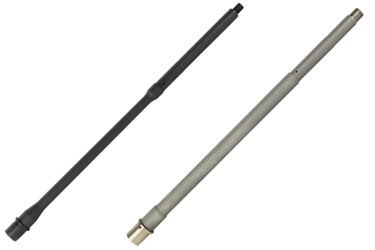416R Stainless vs. 4150 Carbon: Which Barrel Steel is Better
Posted by Gunbuilders.com on Jul 24th 2025
Whether you're building your first AR-15 from scratch, upgrading to a new upper receiver, or swapping barrels on your rifle, you've gotta pick between two types of steel: Carbon, or stainless.
While there are different grades of each type of steel, more than 90% of all barrels made today use either 4150 carbon steel, or 416R stainless steel.
Which one's better? Is one better, and why? Here are the answers.
What is 4150 Steel?

Also often called "CMV," "4150 CMV," or just "Chromoly Vanadium," 4150 steel is the mil-spec steel used to make the barrels for most military-issued rifles, like the M4 and M16.
Its high carbon content makes the steel incredibly hard and wear-resistant, making it suitable for rapid and fully automatic fire.
What is 416R Stainless?

416R stainless was designed specifically for making highly accurate gun barrels. This alloy's properties make it great at handling both high heat and below-freezing temperatures (something past stainlss steels failed to do reliably) while also being easy to precisely machine.
That last bit is important, because its 416R's high machinability that makes this particular stainless steel favored among precision shooters and match barrel makers.
Which Offers The Best Accuracy?
If you want to maximize accuracy, 416R stainless is the best barrel steel.
When paired with cut rifling, a 416R stainless barrel offers literally unbeatable accuracy; skilled marksmen can obtain sub-MOA groupings at long distances with a stainless barrel and the right match-grade cartridge.
Of course, 4150 carbon steel barrels are also capable of providing sub-MOA accuracy. That's particularly true when these barrels using cut rifling, too. If you're building a tactical rifle and you aren't interested in dedicated long-range accuracy, you likely won't notice a difference in performance between these two barrel steels.
Which Offers The Longest Barrel Life?
If you want to maximize barrel life, 4150 carbon is the best barrel steel.
This is because carbon steel barrels are much harder than stainless barrels. The carbon and other hardening elements in 4150 allow it to provide up to two to three times more barrel life if subjected to rapid or automatic fire, especially when paired with a chrome lining or nitride finish.
However, it's important to note that when both steels are subjected to semiautomatic fire with a moderate firing schedule -- like targeting shooting, or even competitive shooting -- both steels will afford a long barrel life.
Under these conditions, a stainless barrel will suffer little wear, and can provide up to 70% of the same life as a carbon steel barrel.
I Want Easy Maintenance. Which Steel's Best?
Stainless barrels are generally easier to clean (chrome lined carbon barrels provide the same benefit, but with a caveat).
Stainless steel has a unique advantage over carbon steel: Its chromium content forms a continuous chrome oxide layer in the bore, which protects the steel from corrosion. This oxide layer is incredibly hard and non-porous, which means carbon fouling and copper deposits don't stick well to it.
This makes stainless barrels easier to clean. They're also highly resistant to corrosion normally caused by spent gunpowder residue left in the bore. Carbon steel barrels can offer similar ease of maintenance, though. A chrome lining offers virtually the same benefits.
But there is a drawback to a chrome lining. Unlike stainless barrels, chrome linings can reduce accuracy. So, if you want maximum accuracy and easy cleaning, stainless is still the better choice.
What's Best for a Good, Do-It-All Build?
If you want a balance of accuracy, lifespan, easy cleaning, and heat resistance, go with a nitride-treated carbon barrel.
The carbon steel barrel offers a more well-rounded blend of performance. Stainless steel barrels are meant for dedicated accuracy. A nitride treatment allows a carbon steel barrel to offer more accuracy than one with a chrome lining, while still providing easier cleaning and good heat tolerance.
Read more about chrome linings vs. nitride treatments here.
DISCLAIMER: If you are new to the world of DIY gun building, you likely have a lot of questions and rightfully so. It’s an area that has a lot of questions that, without the correct answers, could have some serious implications. At GunBuilders.com, we are by no means providing this content on our website to serve as legal advice or legal counsel. We encourage each and every builder to perform their own research around their respective State laws as well as educating themselves on the Federal laws. When performing your own research, please be sure that you are getting your information from a reliable source.

